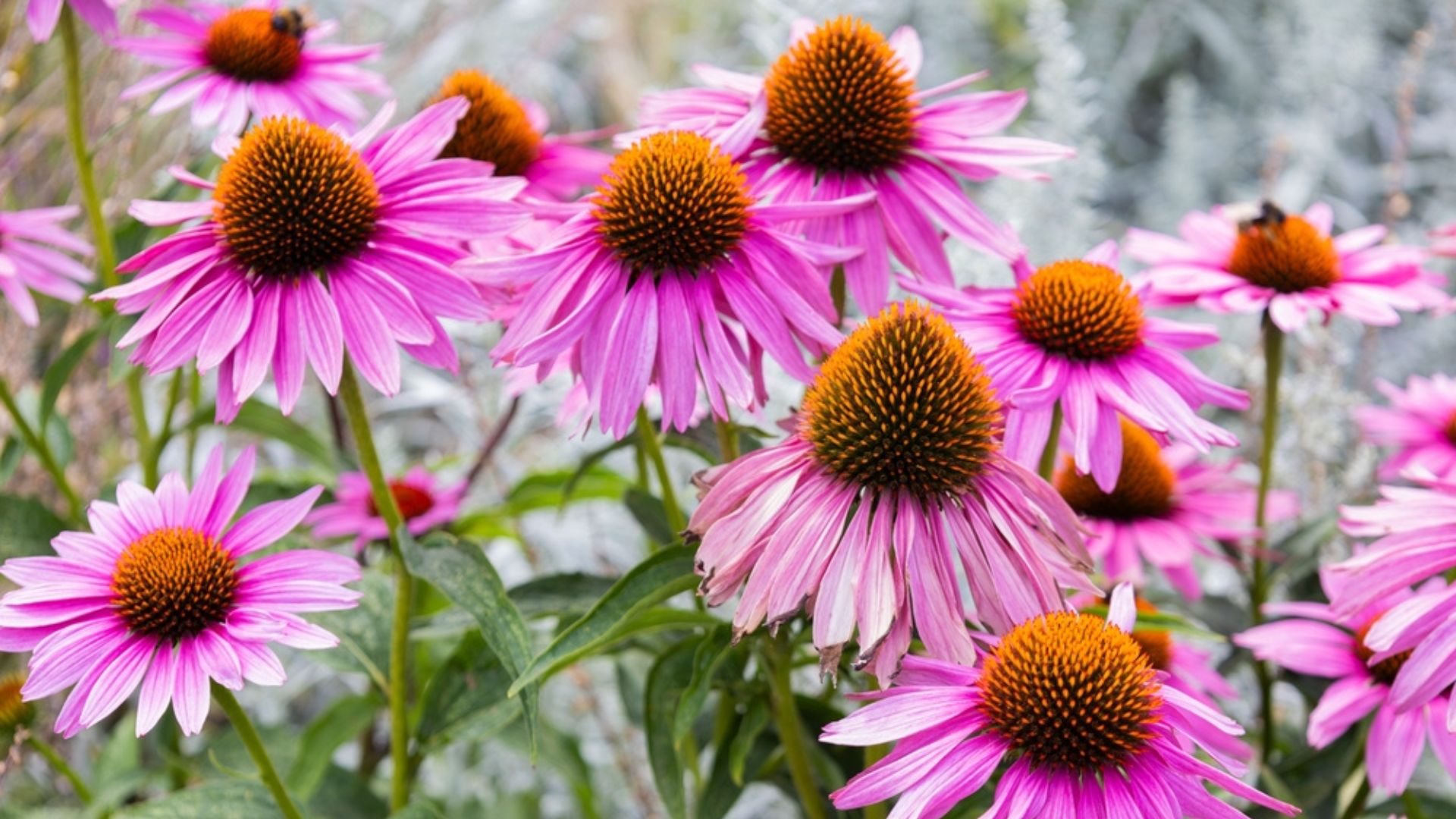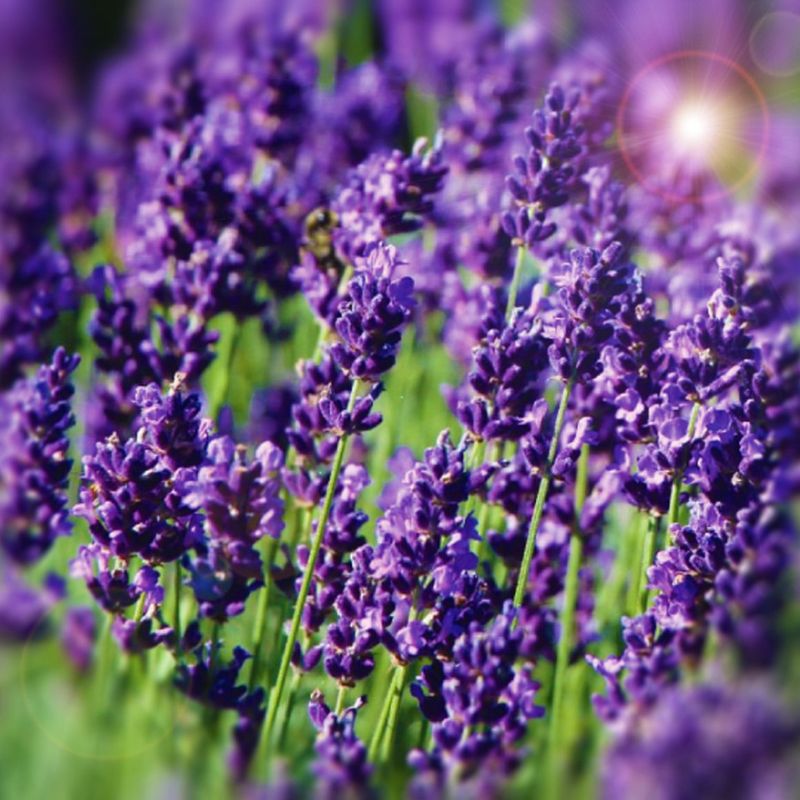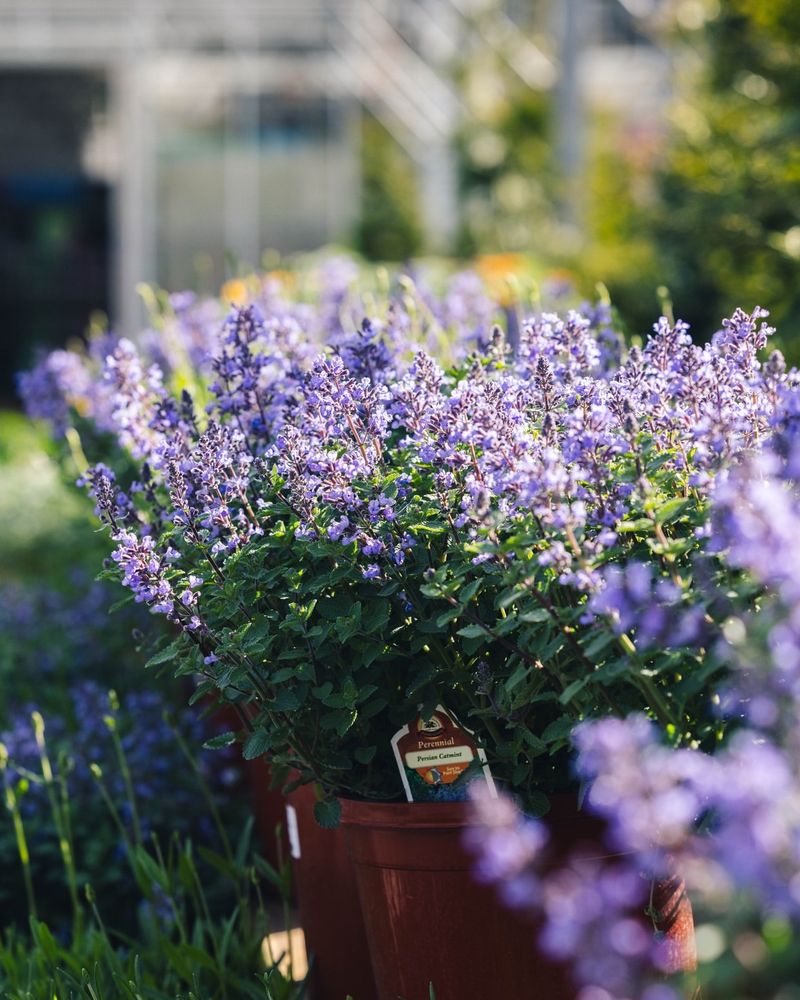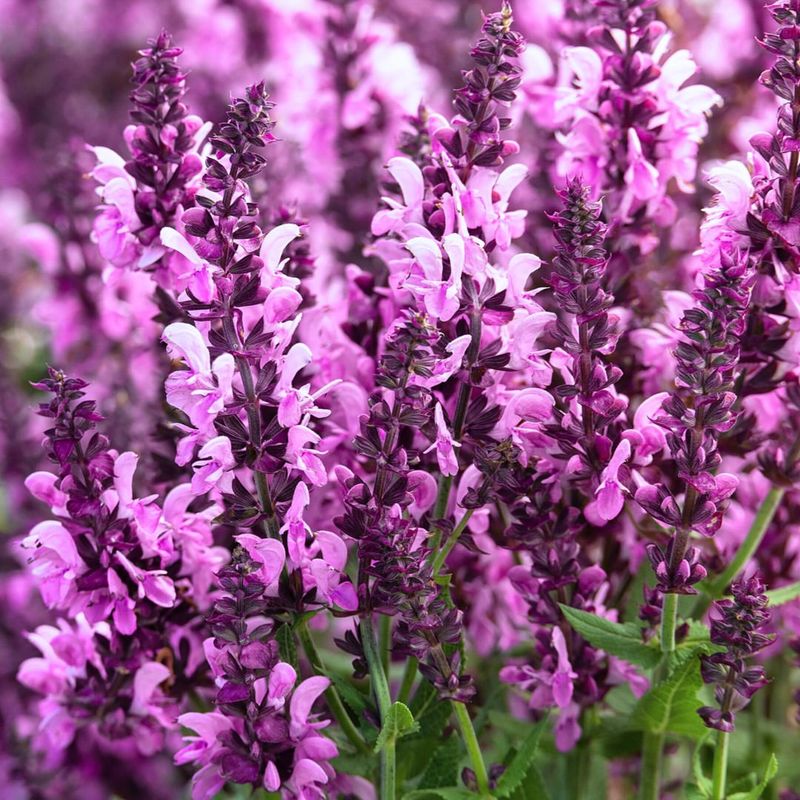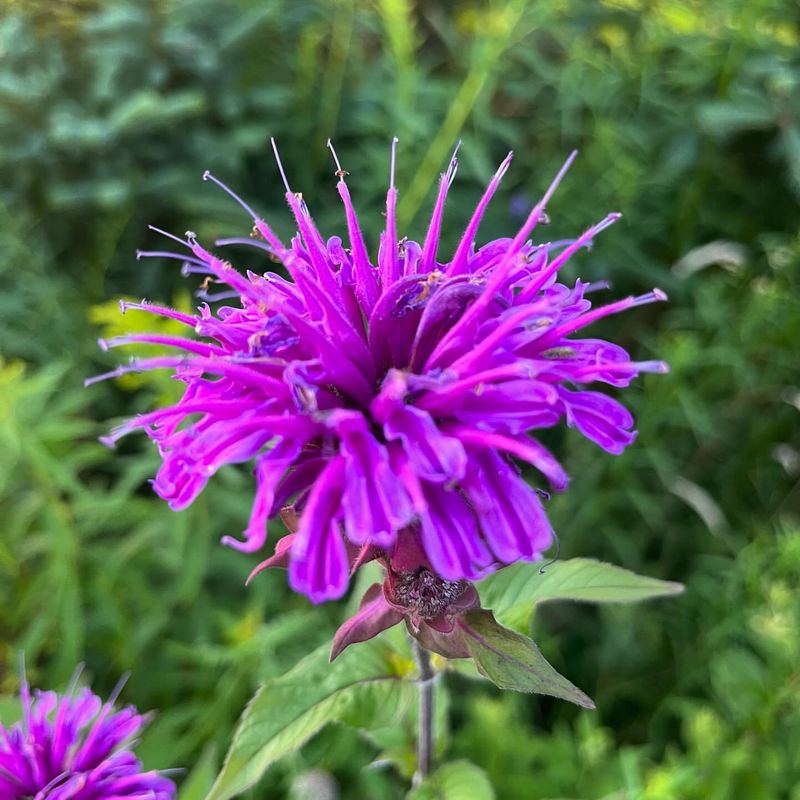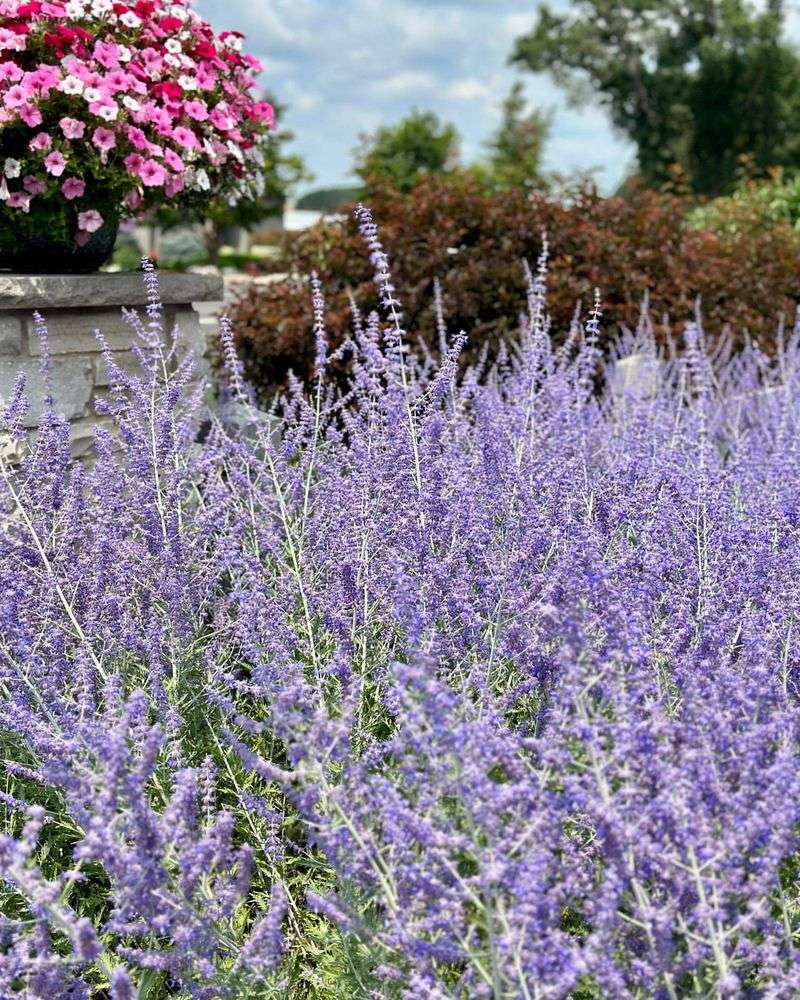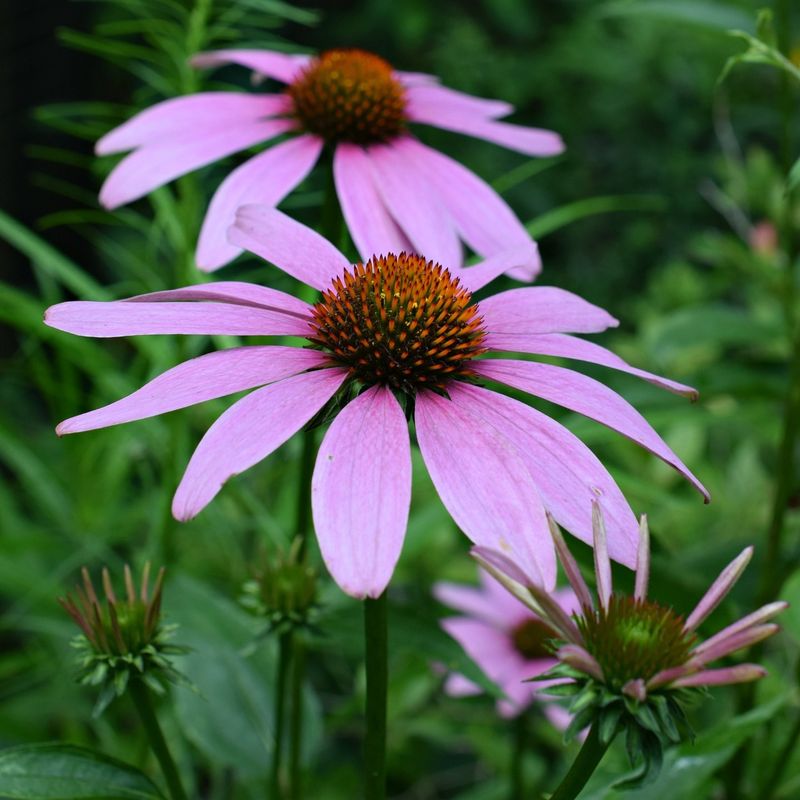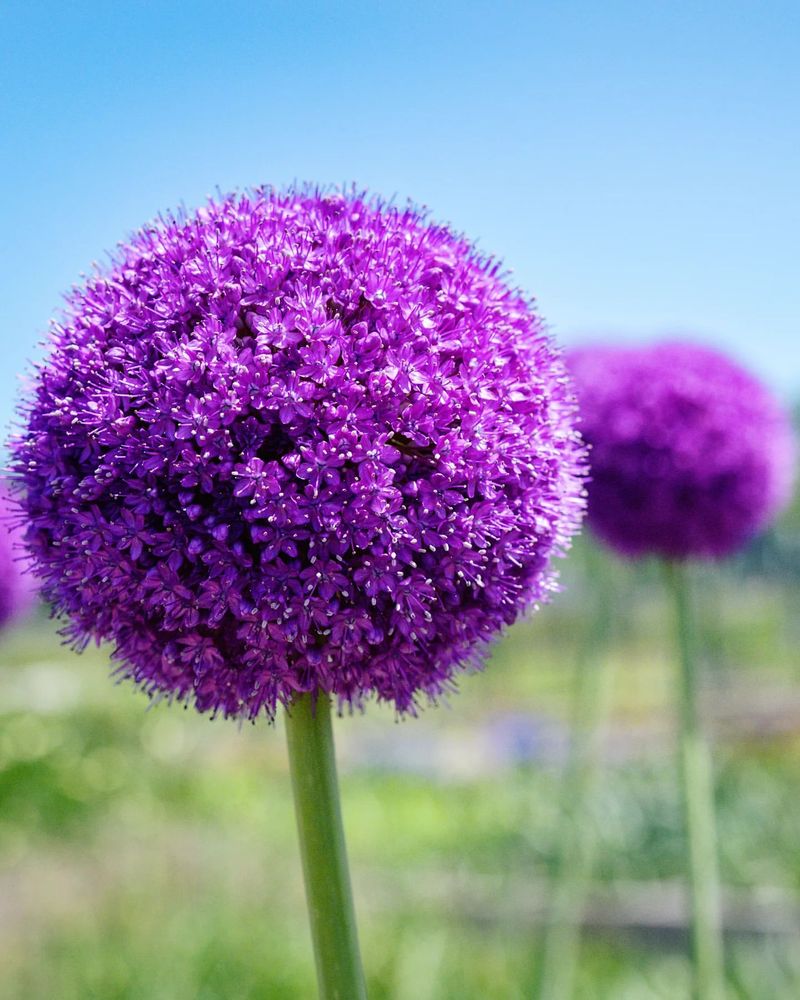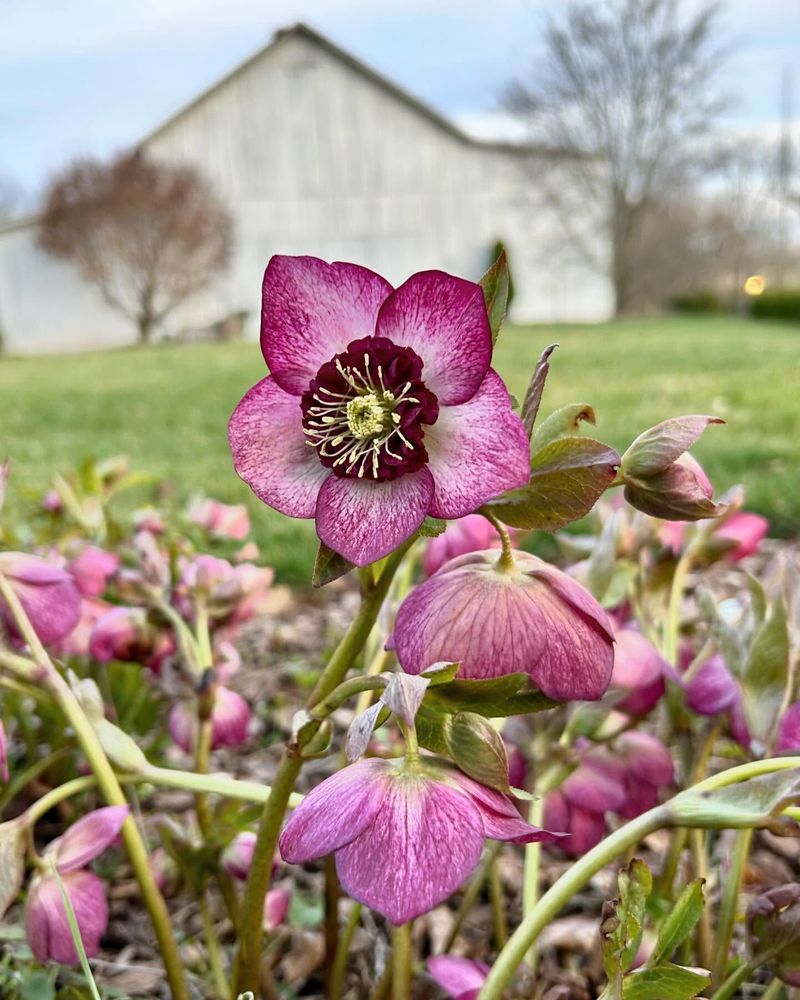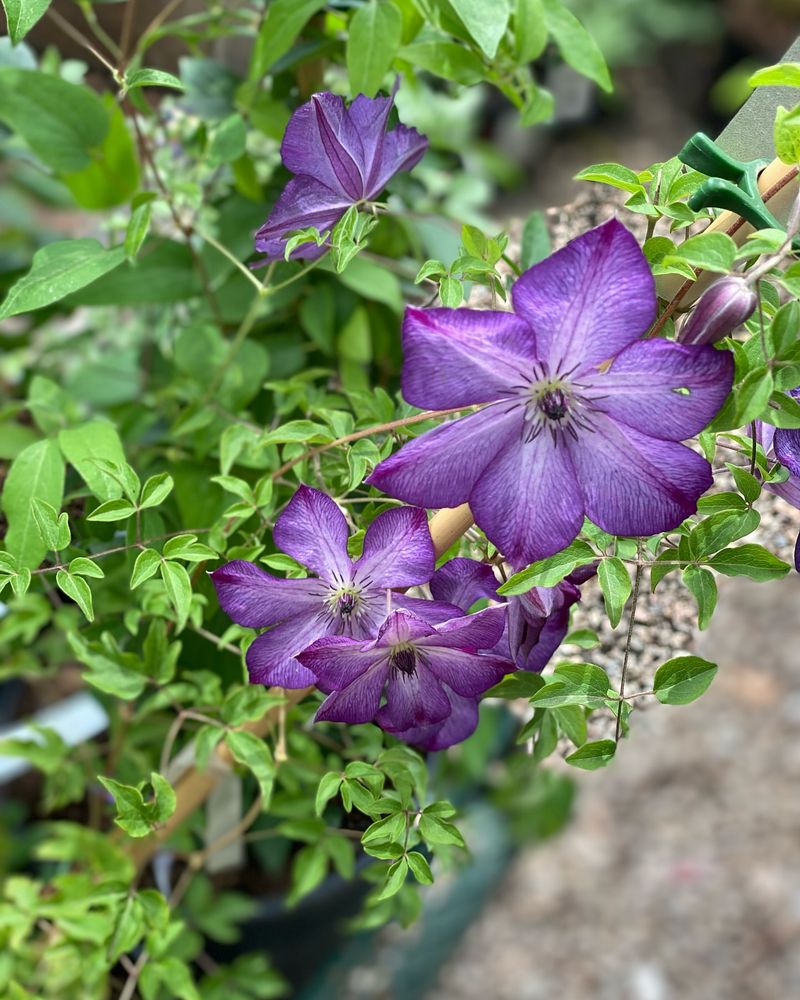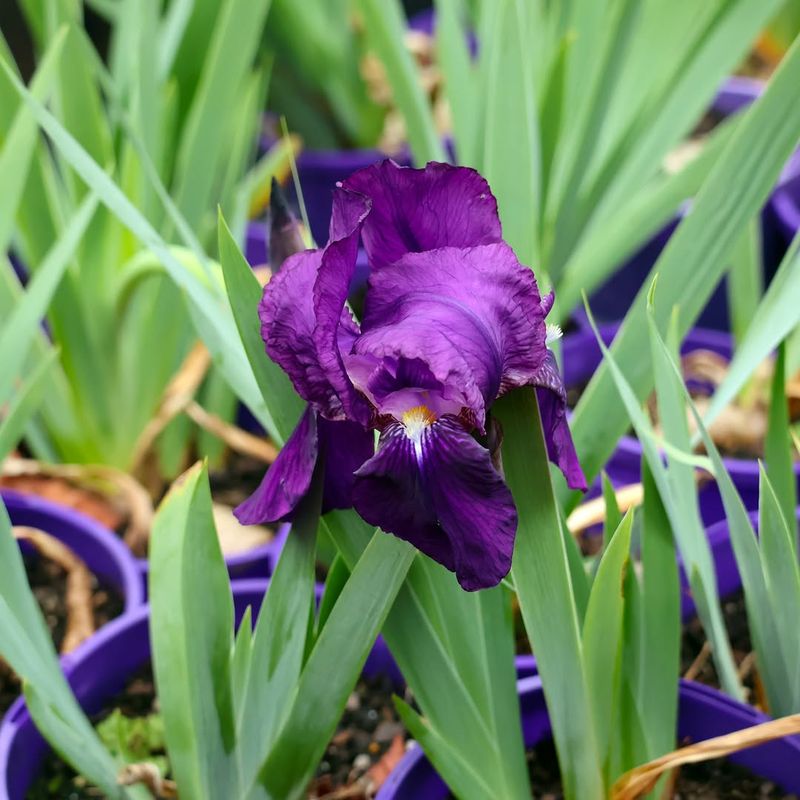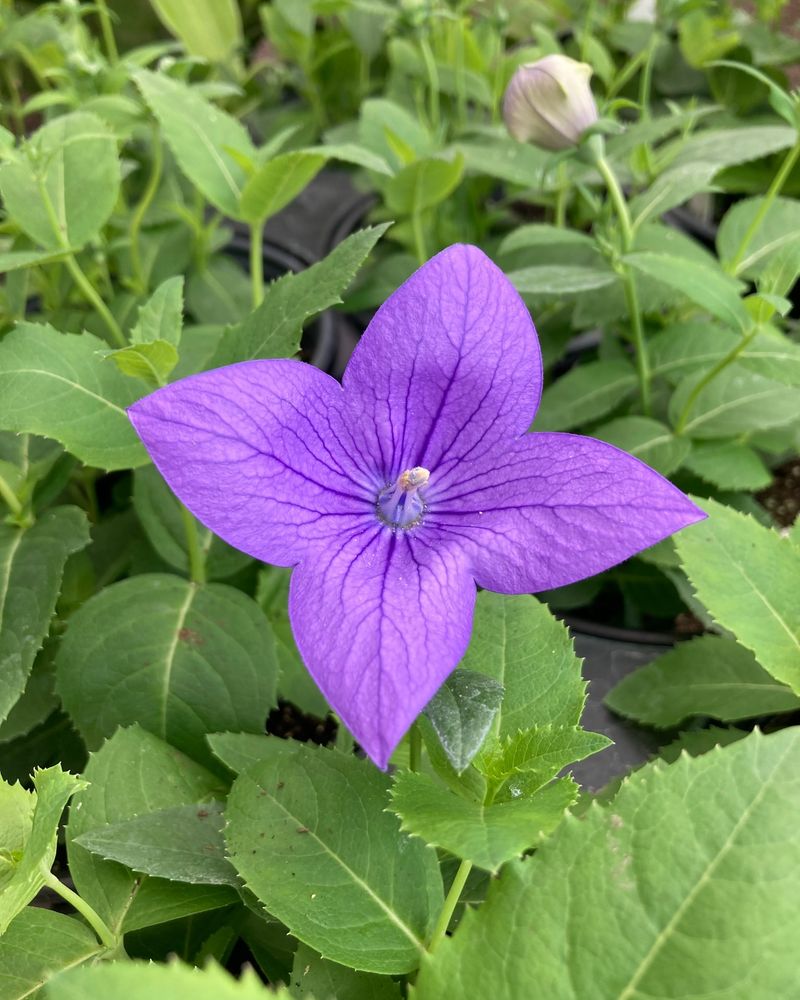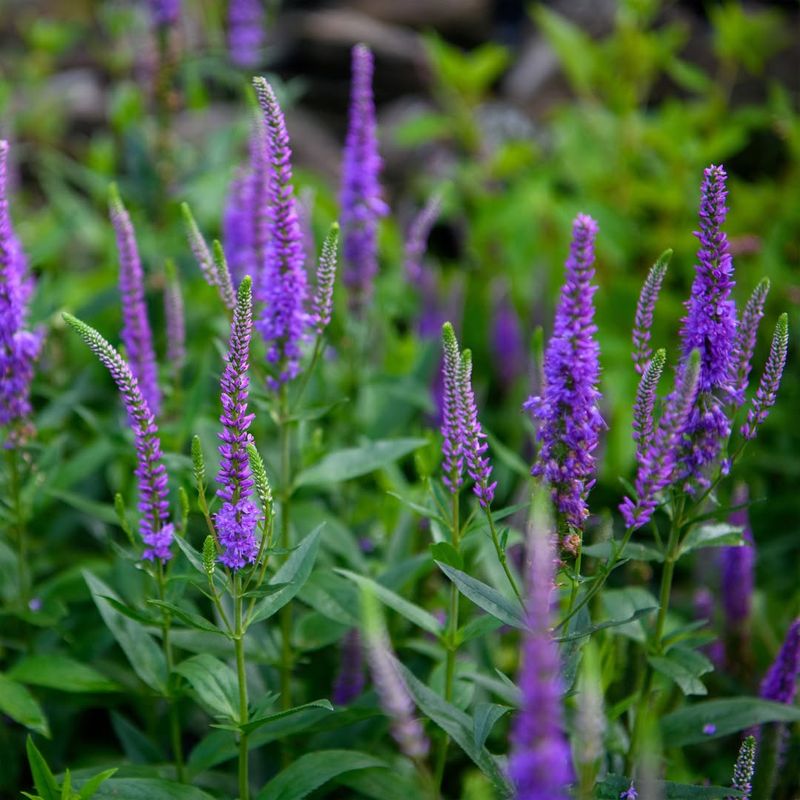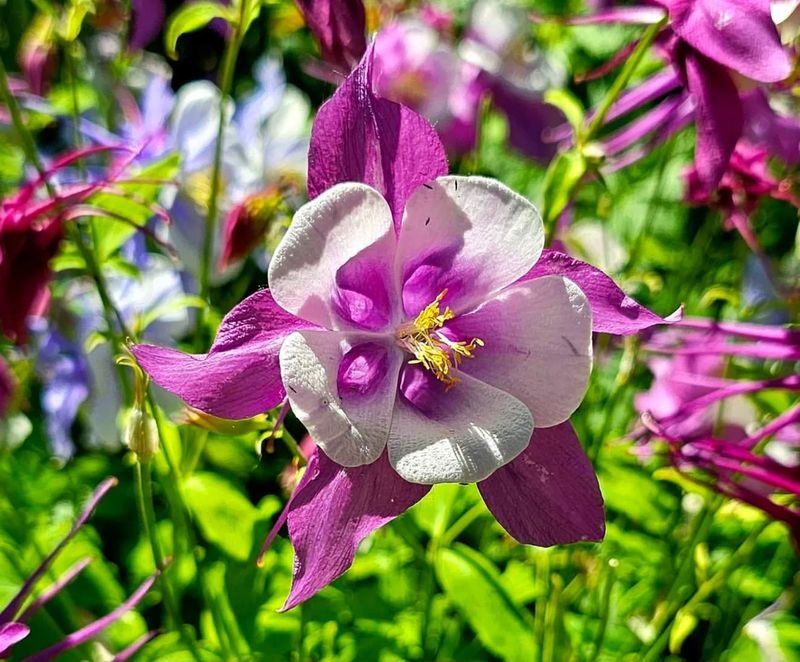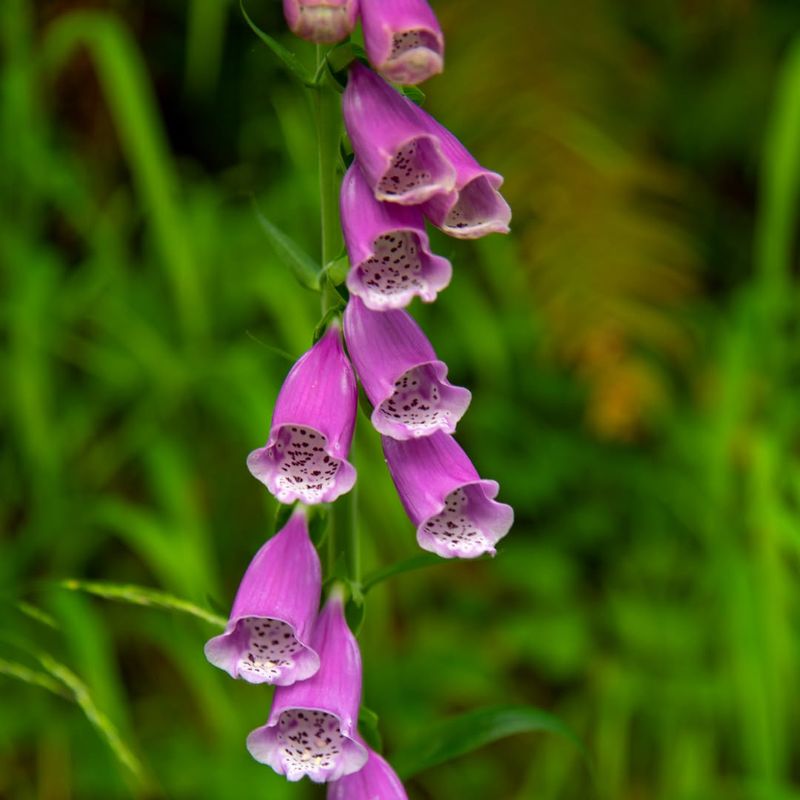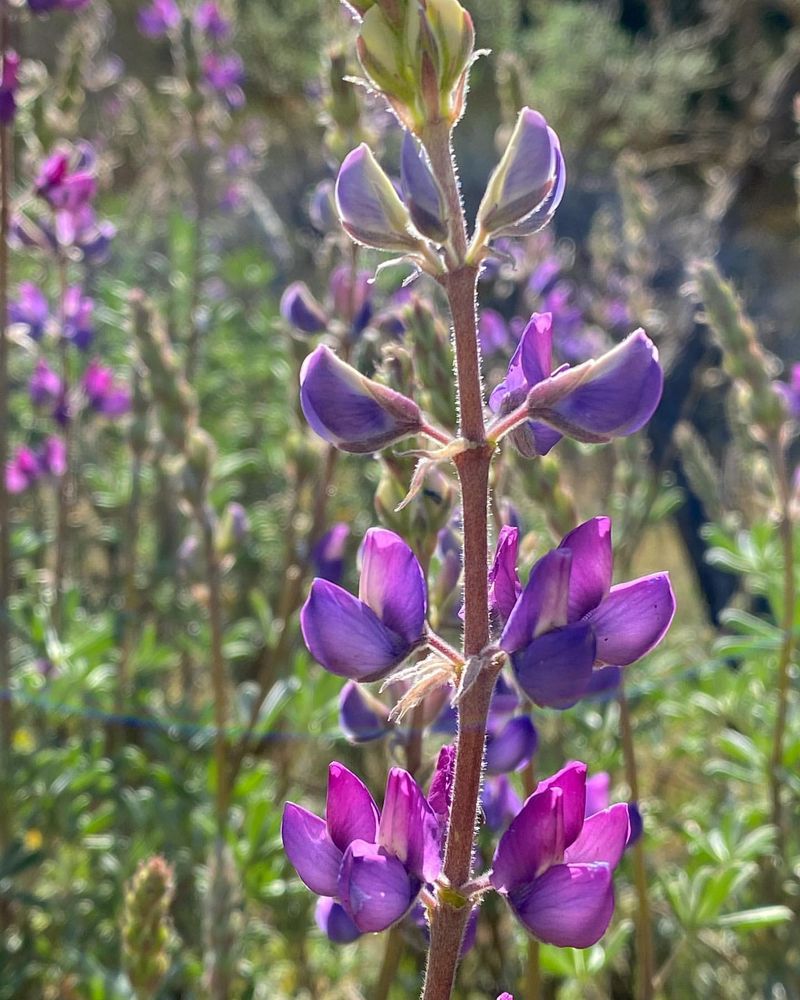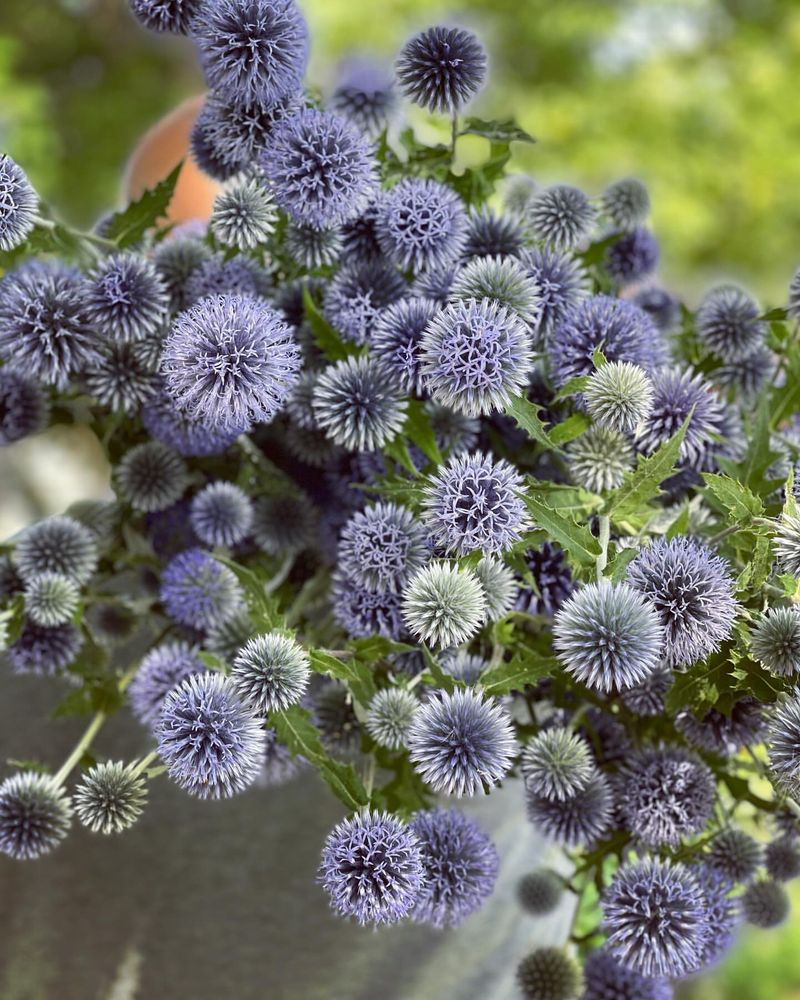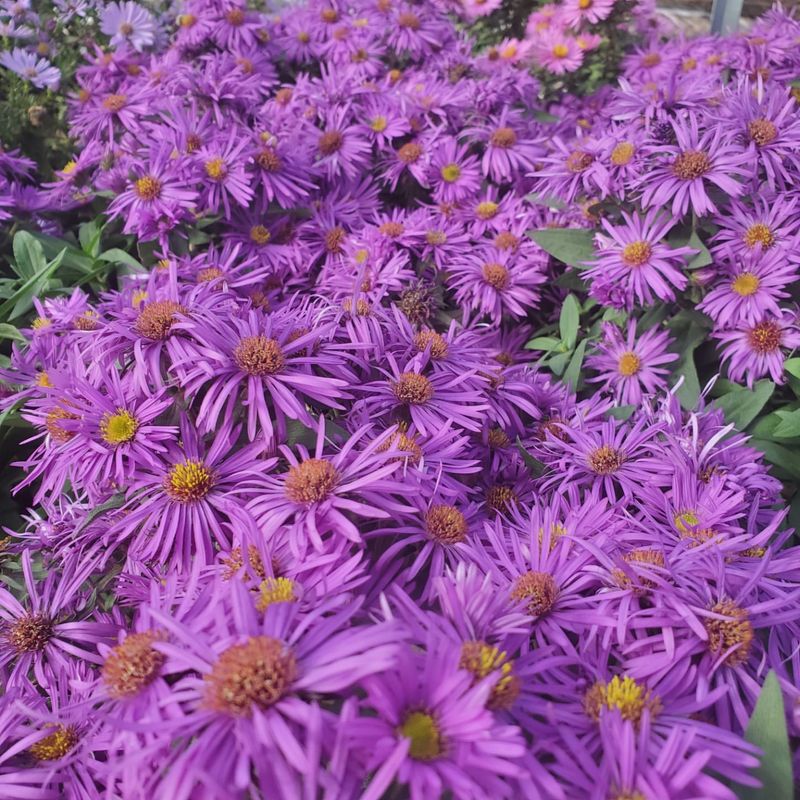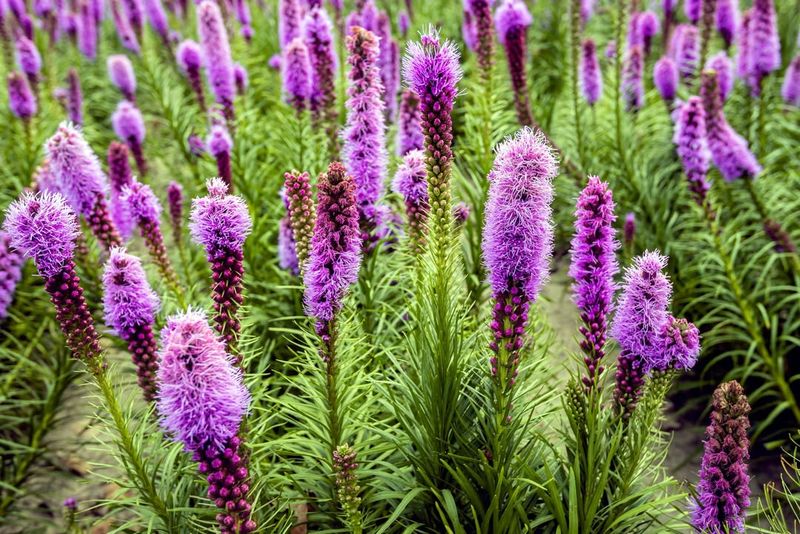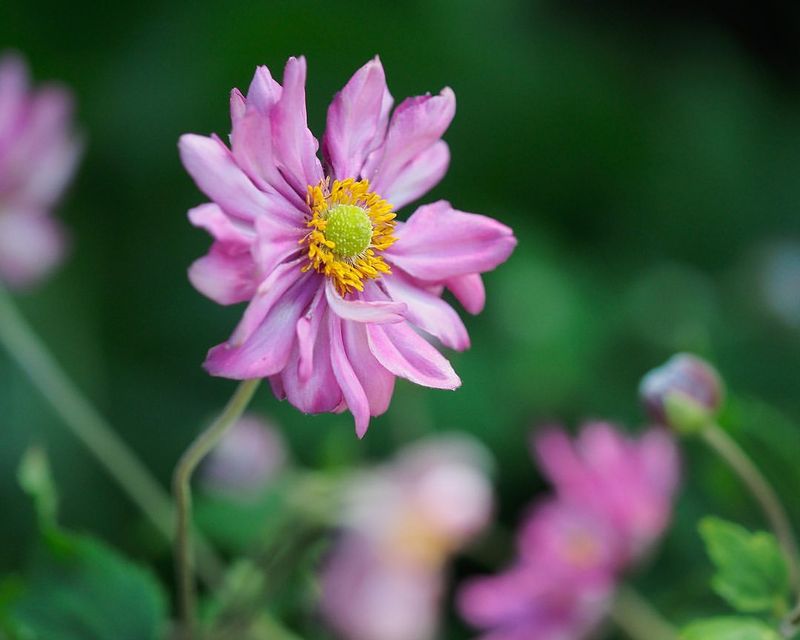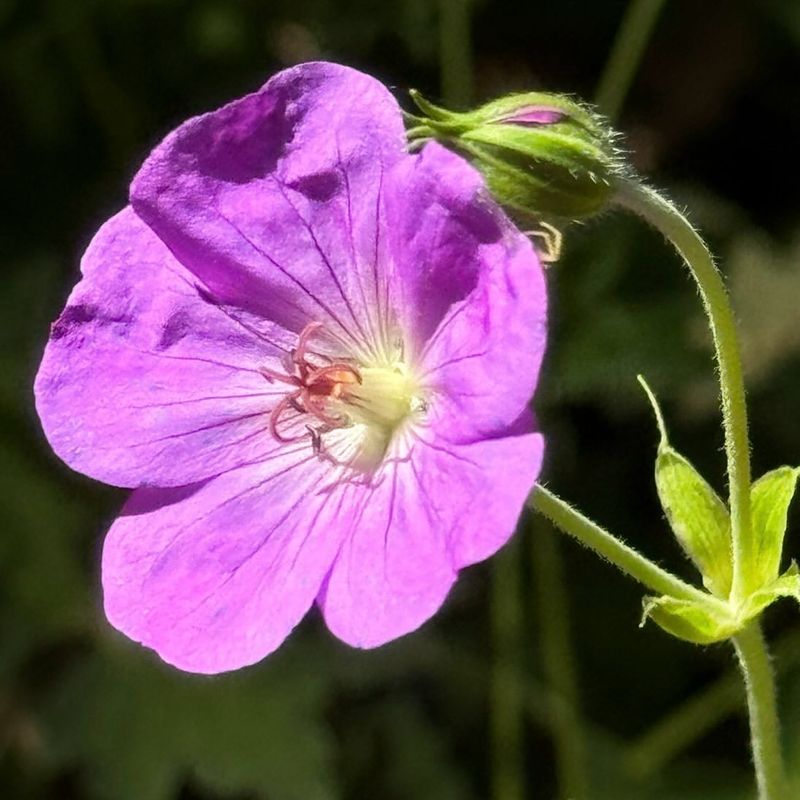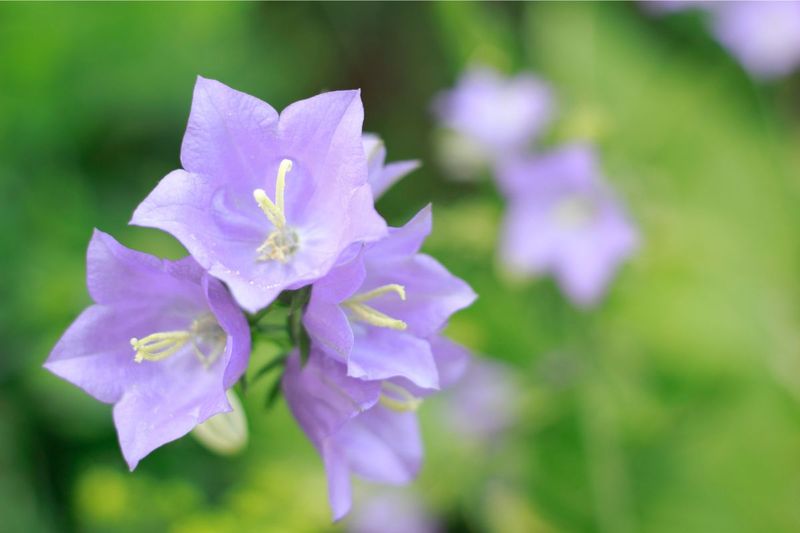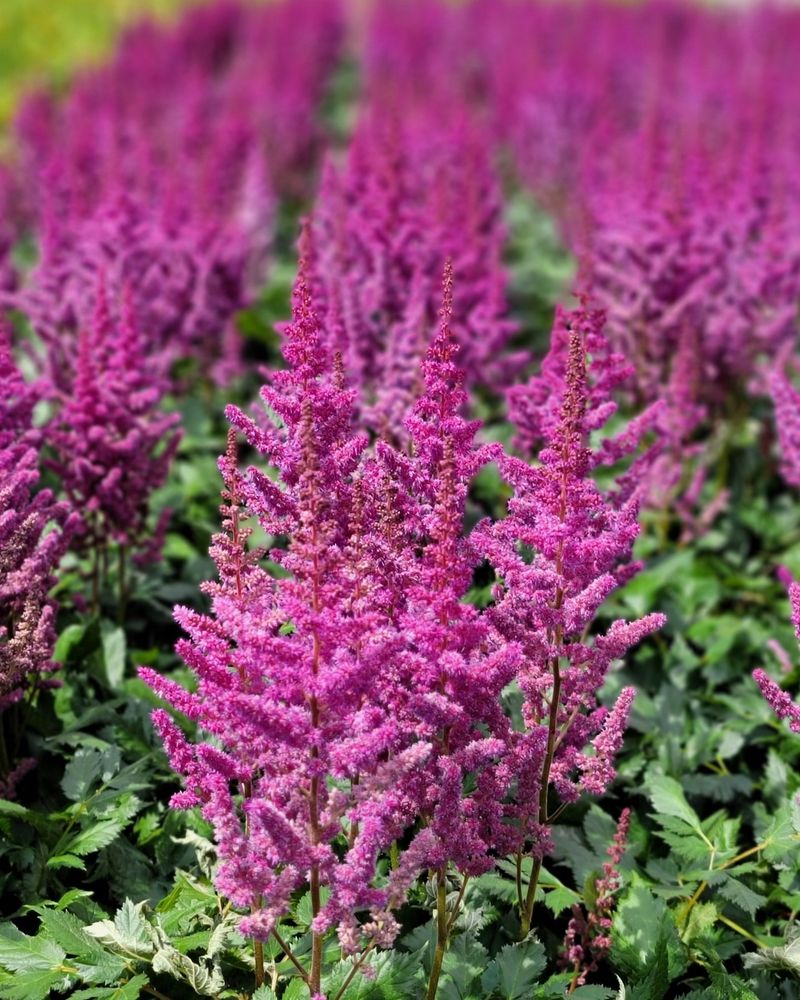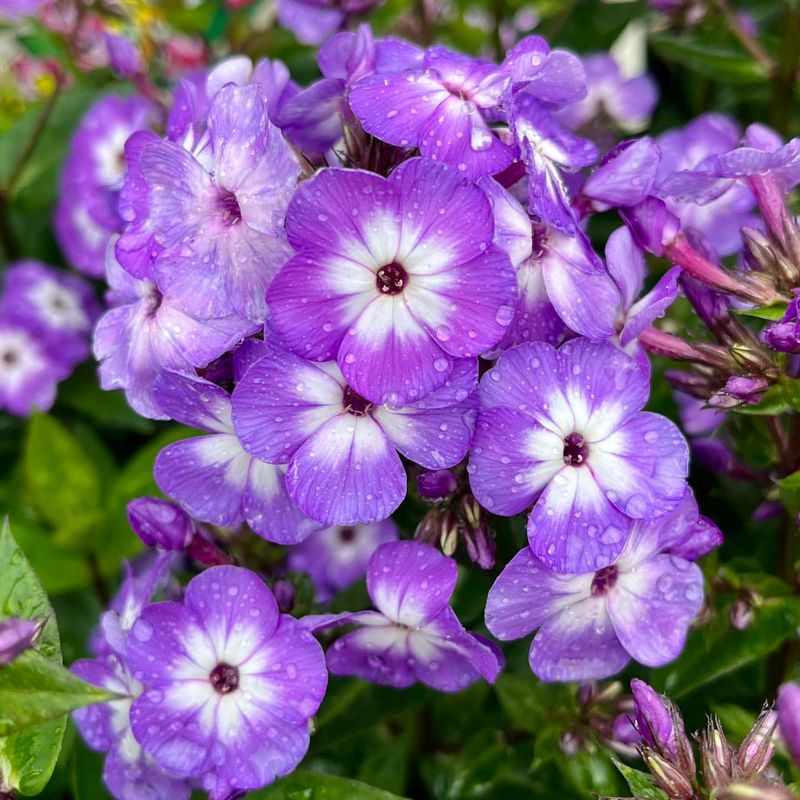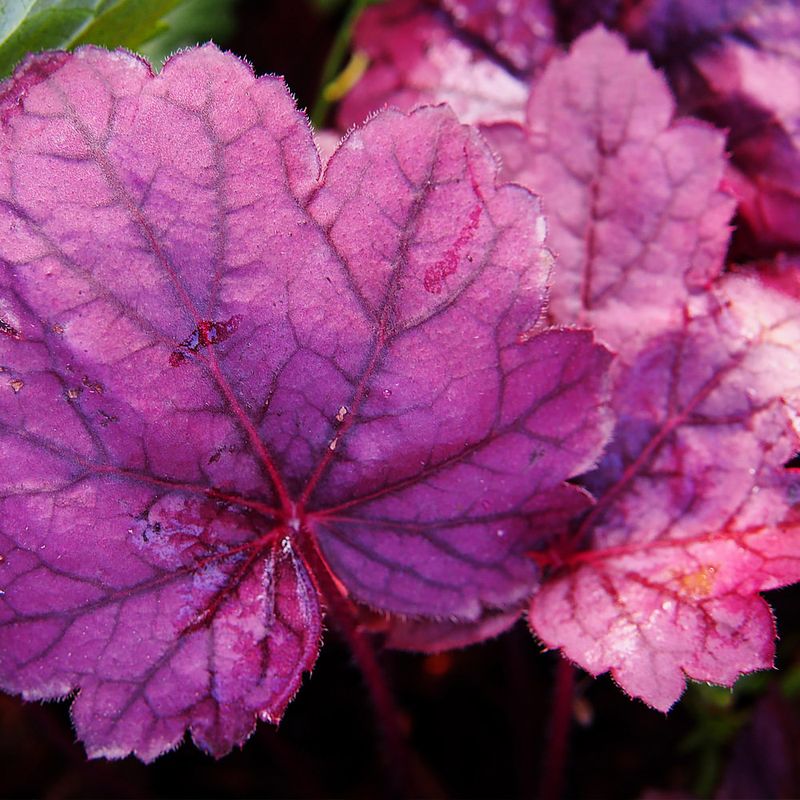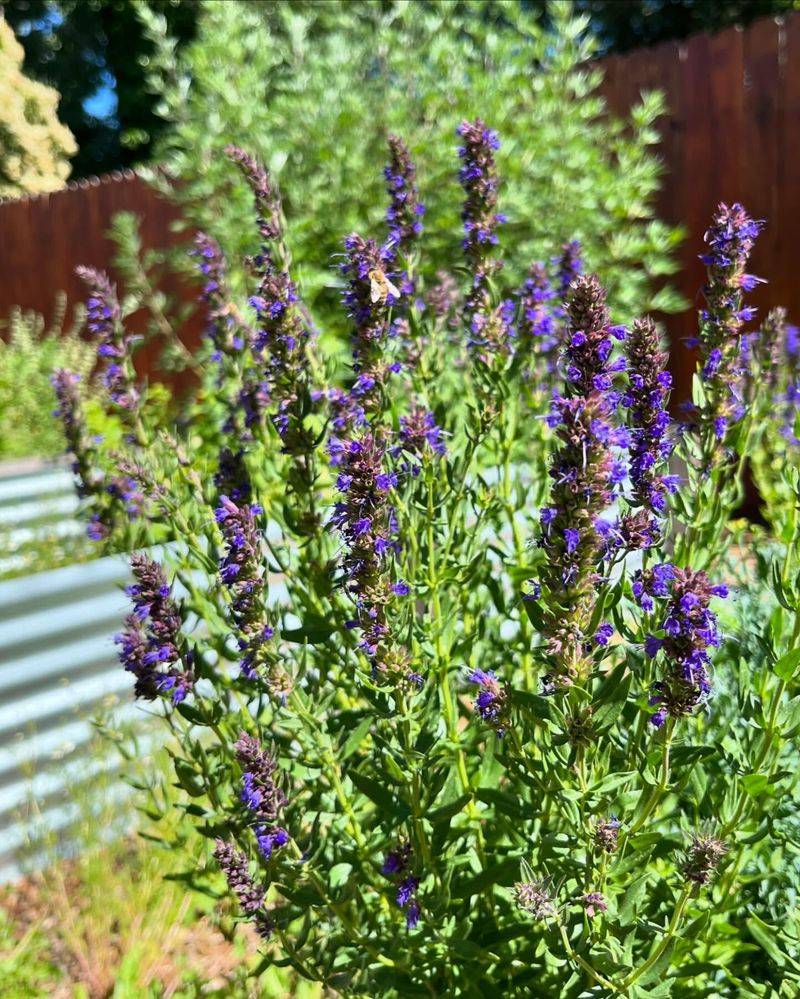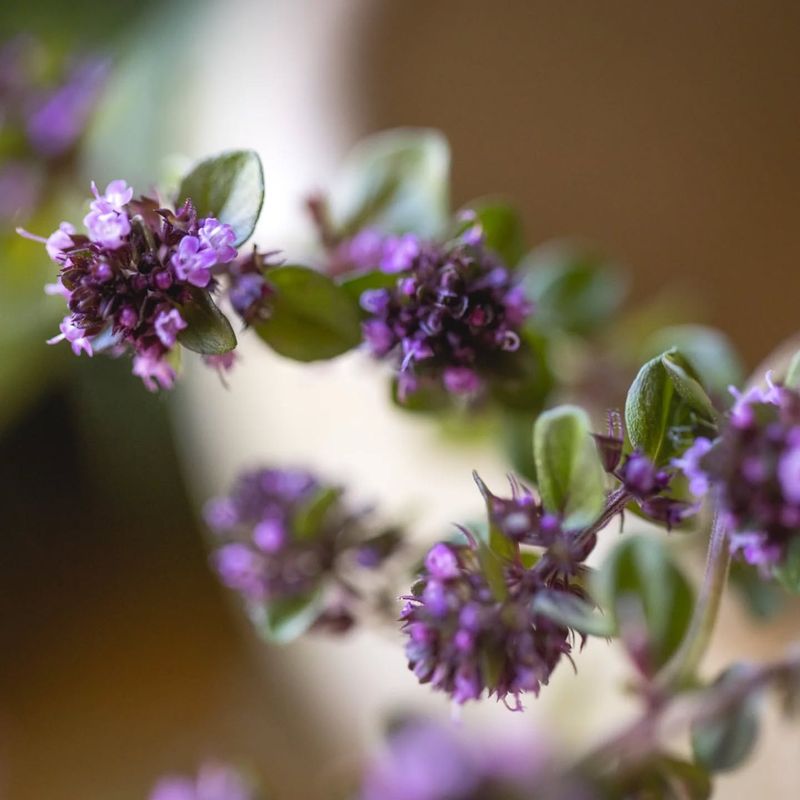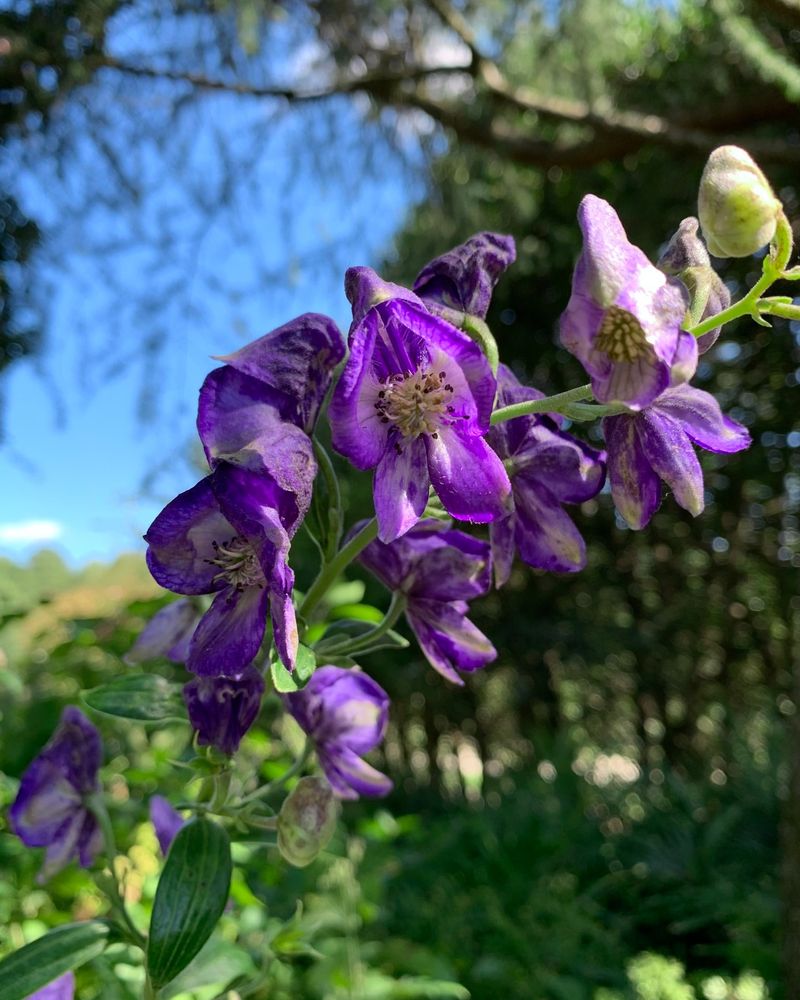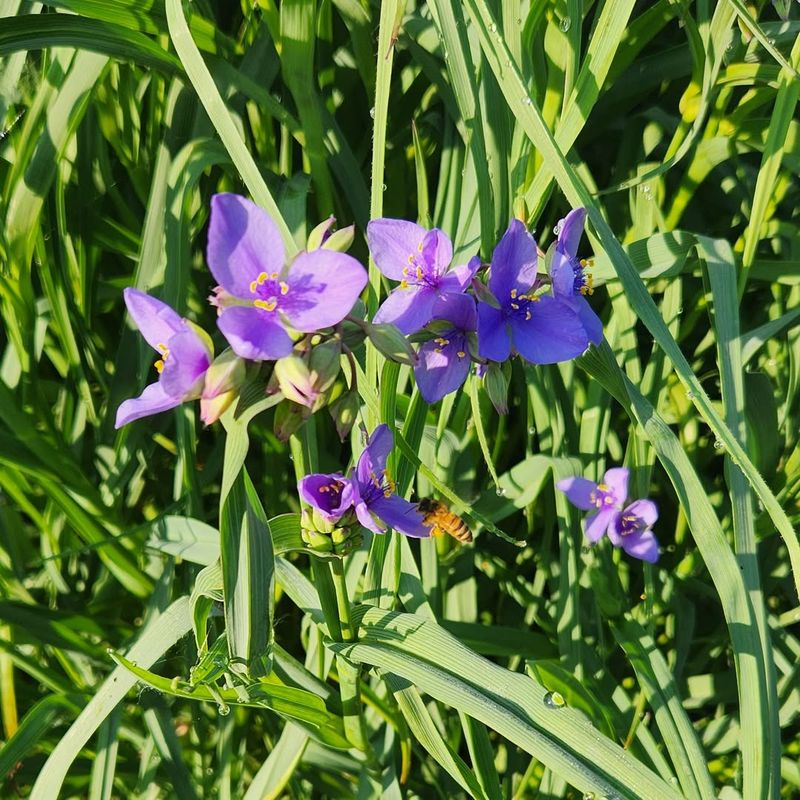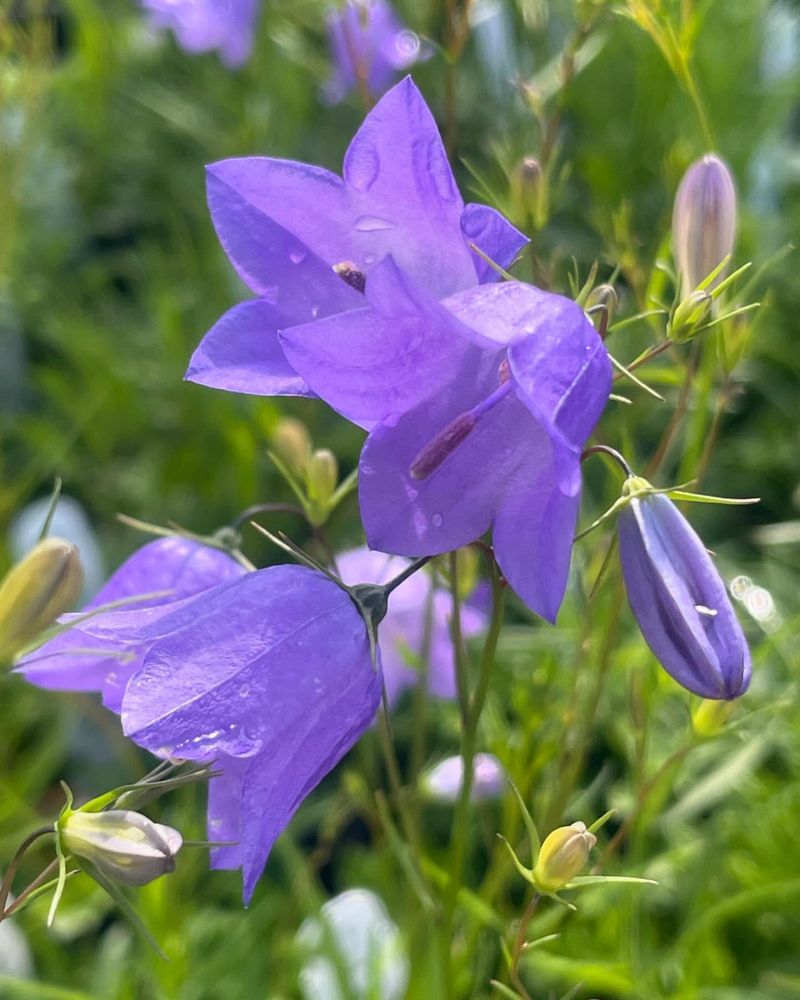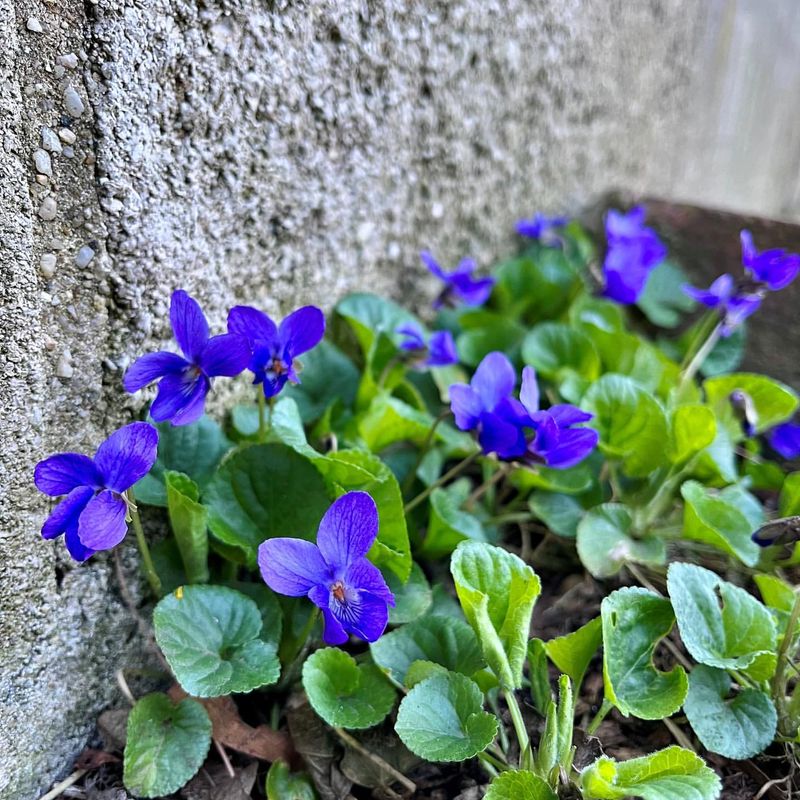Purple perennials offer a stunning array of colors and textures that can enhance any garden.
From delicate blooms to bold, showy flowers, these perennials provide year-round beauty and attract pollinators, making them a valuable addition to any landscape.
1. Lavender (Lavandula)
In gardens where the aromatic scent of herbs is desired, lavender is a standout choice. This perennial is known for its beautiful, fragrant purple spikes that captivate any passerby.
Lavender thrives in sunny environments, requiring well-drained soil to flourish. Its silvery-green foliage provides a soft contrast to its vibrant blooms, creating an eye-catching display.
Besides its ornamental beauty, lavender is practical too. It’s often used in making essential oils and sachets, adding a relaxing aroma to homes. Gardeners find it versatile and rewarding.
2. Catmint (Nepeta)
Gardeners looking for a hardy yet beautiful plant will appreciate catmint’s appeal. Its clusters of small, purple flowers are a treat for the eyes.
Unlike other perennials, catmint is easy to grow and maintain, thriving in various soil conditions. Its lush green leaves add texture to gardens, complementing other plants.
Catmint also attracts pollinators, such as butterflies, enhancing the biodiversity of your garden. Its drought resistance makes it a sustainable choice for eco-conscious gardeners.
3. Salvia (Salvia nemorosa)
Adding a splash of vibrant color to any garden, salvia is a must-have for flower enthusiasts. Its tall, purple stalks draw attention easily.
Salvia thrives in full sun, making it perfect for open garden spaces. Its low-maintenance nature allows even novice gardeners to enjoy its beauty.
This perennial not only decorates gardens but also supports ecosystem health by attracting pollinators. It’s a plant that combines aesthetic appeal with environmental benefits.
4. Bee Balm (Monarda)
For those interested in attracting wildlife, bee balm offers an extraordinary option. Its striking purple blooms are a favorite among bees and hummingbirds.
Bee balm prefers moist, well-drained soil and partial shade, making it versatile for different garden settings. Its aromatic foliage adds a pleasant scent to the garden.
This perennial not only enhances garden aesthetics but also plays a vital role in supporting pollinators. It’s an excellent choice for eco-friendly gardening.
5. Russian Sage (Perovskia atriplicifolia)
In gardens where unique texture and color are desired, Russian sage stands out. Its tall, silvery stems and small purple flowers create a stunning visual contrast.
This perennial thrives in dry conditions, making it ideal for xeriscaping and drought-prone areas. Its resilience ensures long-lasting beauty in various climates.
Russian sage adds not only visual appeal but also fragrance, enhancing the sensory experience in gardens. It’s a plant that combines practicality with elegance.
6. Coneflower (Echinacea)
A delightful addition to any garden is the coneflower, renowned for its distinctive purple petals and prominent central cone.
Coneflowers are robust perennials that adapt well to different soil types, thriving in full sun. Their long-lasting blooms provide continual color throughout the growing season.
These flowers are more than just decorative; they also attract butterflies and birds, supporting local wildlife. Coneflowers are a garden staple that offers beauty and ecological benefits.
7. Allium (Allium giganteum)
Those seeking a dramatic floral display will find Allium irresistible. Its spherical purple blooms rise majestically above garden foliage.
This perennial prefers sunny locations and well-drained soil, making it suitable for various garden styles. Its towering presence adds vertical interest and draws the eye upward.
Beyond its aesthetic charm, Allium is low-maintenance and deer-resistant, offering practical solutions for gardeners. It’s truly a standout plant that leaves a lasting impression.
8. Hellebore (Helleborus)
In shaded corners of the garden, hellebore finds its place, offering early spring blooms in enchanting purple shades.
Known for its tolerance to shade and cold, hellebore is a resilient perennial that brings color to otherwise dim areas. Its leathery leaves provide year-round interest.
Besides its beauty, hellebore is rich in cultural history, often associated with folklore and traditional medicine. It’s a plant that combines ornamental appeal with intriguing background.
9. Clematis (Clematis viticella)
Transforming any vertical space, clematis offers stunning flowers that captivate onlookers. Its large purple blooms are particularly striking.
This climbing perennial thrives in sunny to partially shaded areas, making it versatile for different garden designs. Its ability to climb structures adds an architectural element.
Beyond its beauty, clematis requires regular pruning to promote healthy growth, offering gardeners a hands-on experience. It’s a rewarding plant that fills spaces with vibrant color.
10. Iris (Iris germanica)
Among the array of garden plants, the iris stands out with its intricate purple petals and elegant form. This perennial is a garden classic.
Iris requires well-drained soil and plenty of sunlight to thrive, often blooming in late spring to early summer. Its sword-like leaves add structural interest.
Gardeners appreciate iris not only for its beauty but also for its symbolic meanings, often associated with wisdom and valor. It’s a plant that enriches gardens aesthetically and culturally.
11. Balloon Flower (Platycodon grandiflorus)
In gardens where unique shapes are prized, the balloon flower offers a whimsical touch. Its balloon-shaped buds intrigue before bursting into star-like purple blooms.
This perennial is low-maintenance, preferring sunny locations and well-drained soil. Its long blooming period ensures extended garden enjoyment.
Beyond its visual charm, the balloon flower is a symbol of friendship and endless love, adding emotional value to gardens. It’s a delightful plant that captivates hearts and eyes.
12. Veronica (Veronica spicata)
For those seeking vertical interest, Veronica offers spiky purple blooms that add height to garden beds.
This perennial thrives in sunny locations, requiring minimal care, making it ideal for busy gardeners. Its green foliage complements its vibrant flowers beautifully.
Veronica not only enhances garden aesthetics but also supports pollinators, making it an environmentally friendly choice. It’s a plant that effortlessly combines form and function.
13. Columbine (Aquilegia)
In the realm of delicate blooms, columbine makes a graceful entrance with its spurred purple petals.
This perennial thrives in partial shade, adding a touch of elegance to woodland gardens. Its unique flower shape is a conversation starter.
Columbine also attracts hummingbirds, bringing lively activity to garden spaces. It’s not just a visual delight but also a hub of ecological interaction.
14. Foxglove (Digitalis purpurea)
The charm of cottage gardens often includes the towering foxglove, with its elegant spires of tubular purple flowers.
Best suited for partially shaded areas, foxglove adds vertical interest and a classic touch to traditional garden settings.
While beautiful, foxglove is toxic if ingested, requiring careful placement away from pets and children. Its allure is matched by its need for mindful handling.
15. Lupine (Lupinus)
For a vibrant display of color and form, lupine is unmatched. Its tall spikes of purple flowers create striking visual drama.
Lupine thrives in sunny locations with well-drained soil, making it suitable for diverse garden environments. Its nitrogen-fixing ability benefits soil health.
Besides its visual impact, lupine supports pollinators, enhancing garden biodiversity. It’s a plant that marries beauty with ecological function.
16. Globe Thistle (Echinops)
In search of unique textures, the globe thistle offers round, spiky purple blooms that stand out in any garden.
This perennial thrives in dry, well-drained conditions, making it perfect for xeriscaping. Its greyish foliage adds additional visual interest.
Beyond its aesthetic appeal, globe thistle is deer-resistant and low-maintenance, providing practical solutions for gardeners. It’s a distinctive plant that enhances garden diversity.
17. Aster (Aster amellus)
With an eye for late-season color, aster provides a burst of purple blooms when many plants have faded.
This perennial thrives in sunny locations, contributing vibrant hues to autumn gardens. Its dainty petals and yellow centers attract pollinators.
Asters are not only visually appealing but also hardy, tolerating a variety of soil conditions. They’re a reliable choice for extending garden beauty into fall.
18. Liatris (Liatris spicata)
Adding vertical elegance to gardens, liatris showcases tall purple spikes that capture attention.
This perennial thrives in sunny environments, requiring minimal care once established. Its grassy foliage complements its floral display.
Liatris supports pollinators, attracting bees and butterflies to your garden. It’s a plant that offers both beauty and ecological benefits.
19. Anemone (Anemone hupehensis)
In shaded garden corners, anemone offers delicate purple blooms that bring an air of sophistication.
This perennial thrives in partial shade, providing a late summer to fall floral display. Its lush green foliage enhances its visual appeal.
Anemone is more than just ornamental; it adapts well to different soil types, making it a versatile garden choice. It’s a plant that combines grace with adaptability.
20. Geranium (Geranium ‘Rozanne’)
Gardeners seeking continuous blooms will find geranium ‘Rozanne’ a rewarding choice. Its bright purple flowers create a vibrant display.
This perennial thrives in sun to partial shade, offering prolonged flowering throughout the growing season. Its sprawling foliage adds texture to garden beds.
Beyond beauty, geranium ‘Rozanne’ is low-maintenance, making it suitable for gardeners of all experience levels. It’s a plant that offers both ease and elegance.
21. Campanula (Campanula carpatica)
In rocky or alpine gardens, campanula brings charm with its bell-shaped purple blooms. This perennial is a delight to behold.
Campanula thrives in well-drained soils, making it suitable for rock gardens and borders. Its compact foliage adds a neat appearance.
Beyond its visual appeal, campanula is easy to grow, offering gardeners simplicity and beauty. It’s a versatile plant that enhances various garden styles.
22. Astilbe (Astilbe chinensis)
In gardens where shade dominates, astilbe provides colorful feathery plumes that brighten dark corners.
This perennial thrives in moist, shady conditions, making it ideal for woodland gardens. Its fern-like leaves add texture.
Astilbe not only enhances garden aesthetics but also requires minimal maintenance, offering ease for gardeners. It’s a plant that combines beauty with practicality.
23. Phlox (Phlox paniculata)
A staple in cottage gardens, phlox offers clusters of purple blooms that create a cheerful atmosphere.
This perennial thrives in sunny conditions, providing a long-lasting floral display in garden beds and borders. Its lush foliage complements its vibrant flowers.
Beyond beauty, phlox is known for its fragrance, attracting pollinators and adding sensory delight. It’s a plant that marries charm with ecological benefits.
24. Coral Bells (Heuchera)
For those interested in foliage color, coral bells offer striking purple leaves that stand out year-round.
This perennial thrives in partial shade, adding visual interest to shaded garden areas. Its delicate flower spikes provide additional charm.
Beyond aesthetics, coral bells are low-maintenance and deer-resistant, offering practical benefits. It’s a versatile plant that enhances garden diversity.
25. Hyssop (Hyssopus officinalis)
In herbal gardens, hyssop stands out with its aromatic spikes of purple flowers. This perennial is as beautiful as it is useful.
Hyssop thrives in sunny, well-drained locations, making it suitable for various garden settings. Its green foliage complements its floral spikes.
Beyond its ornamental value, hyssop is used in traditional medicine and cooking, adding both flavor and health benefits. It’s a plant that combines aesthetics with utility.
26. Thyme (Thymus vulgaris)
In culinary gardens, thyme offers both aroma and visual appeal with its tiny purple flowers and fragrant leaves.
This perennial thrives in sunny, well-drained conditions, making it ideal for kitchen gardens. Its compact growth habit suits various garden styles.
Beyond its ornamental value, thyme is a versatile herb used in cooking, adding flavor to dishes. It’s a plant that marries beauty with culinary benefits.
27. Corydalis (Corydalis solida)
In shaded gardens, corydalis offers delicate blooms that add a touch of whimsy. Its purple flowers bring charm to garden spaces.
This perennial thrives in partial shade, preferring moist, well-drained soil. Its fern-like foliage adds textural interest.
Beyond its beauty, corydalis is known for its resilience, often blooming early in spring. It’s a plant that combines grace with hardiness.
28. Monkshood (Aconitum)
In gardens where mystique is desired, monkshood offers dramatic hooded purple flowers. This perennial stands out with its unique blooms.
Monkshood thrives in cool, shaded areas, adding vertical drama to garden settings. Its lush foliage provides a soothing backdrop.
While beautiful, monkshood is toxic and requires careful handling. It’s a plant that combines allure with caution.
29. Spiderwort (Tradescantia)
For a plant that offers both beauty and versatility, spiderwort is a great choice. Its purple three-petaled flowers are distinctive.
This perennial thrives in various garden settings, adapting to sun and shade conditions. Its long green leaves add texture.
Beyond aesthetics, spiderwort is easy to maintain, making it an excellent choice for beginner gardeners. It’s a plant that offers both color and simplicity.
30. Bellflower (Campanula rotundifolia)
In meadows where natural beauty is cherished, bellflower offers delicate bell-shaped purple flowers. This perennial is a symbol of grace.
Bellflower thrives in various soil conditions, preferring sunny to partially shaded areas. Its slender stems add a touch of elegance.
Beyond its charm, bellflower attracts pollinators, supporting garden biodiversity. It’s a plant that combines simplicity with ecological benefits.
31. Viola (Viola odorata)
In garden borders, viola adds charm with its vibrant purple petals and heart-shaped leaves. This perennial is a timeless favorite.
Viola thrives in partially shaded areas, offering early spring blooms that brighten garden spaces. Its compact size suits various garden designs.
Beyond beauty, viola is known for its fragrance, adding a sensory dimension to gardens. It’s a plant that combines visual appeal with aromatic delight.

